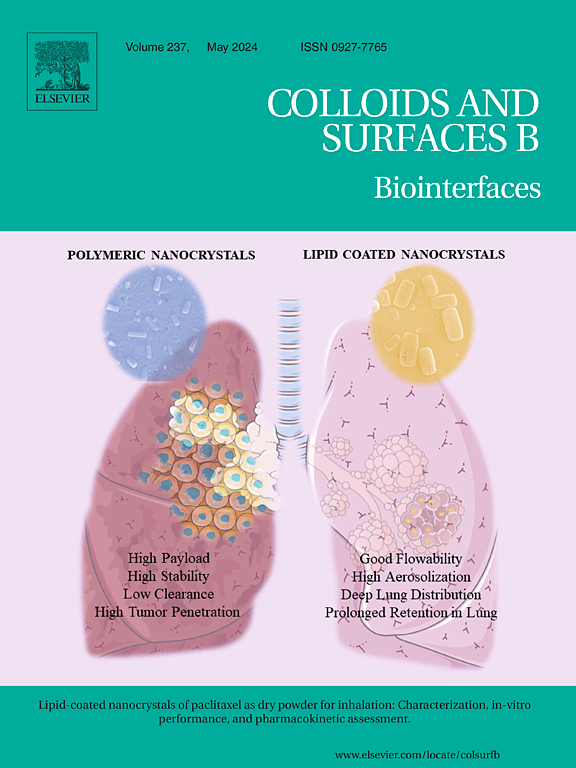One-step on-chip preparation of nanoparticle-conjugated red blood cell carriers
IF 5.4
2区 医学
Q1 BIOPHYSICS
引用次数: 0
Abstract
Red blood cell (RBC)-based carriers have emerged as promising vehicles for drug delivery due to their inherent biocompatibility and biodegradability. Traditional methods for loading nanoparticles (NPs) onto RBC surfaces often involve labor-intensive processes like incubation and multiple centrifugation steps, limiting their practicality and controllability. In this study, we introduce a fully integrated acoustofluidic platform that enables one-step preparation of NP-loaded RBC carriers with controlled modification and on-site purification. By incorporating a high-frequency bulk acoustic wave (BAW) resonator into a microfluidic chip, we utilize acoustic streaming effects to manipulate the movement and interaction of RBCs and NPs within the microchannel. This design allows for precise control over NP loading efficiency by adjusting the input power to the resonator. Experimental results using 200 nm positively charged fluorescent NPs demonstrate that our platform significantly enhances the interaction between RBCs and NPs, achieving efficient and controllable surface loading of NPs onto RBCs. Furthermore, the platform simplifies post-processing by directing excess NPs to waste outlets, eliminating the need for repetitive washing and centrifugation. This acoustofluidics approach not only automates the loading process but also offers high controllability, highlighting its potential for various applications in particle and cell surface modification.
在芯片上一步制备纳米颗粒结合的红细胞载体
基于红细胞(RBC)的载体因其固有的生物相容性和生物可降解性,已成为前景广阔的药物输送载体。将纳米粒子(NPs)载入红细胞表面的传统方法通常涉及孵育和多重离心步骤等劳动密集型过程,限制了其实用性和可控性。在本研究中,我们介绍了一种完全集成的声学流体平台,该平台可实现一步制备 NP 负载的 RBC 载体,并对其进行可控修饰和现场纯化。通过将高频体声波(BAW)谐振器集成到微流控芯片中,我们利用声流效应来操纵微通道内 RBC 和 NPs 的运动和相互作用。这种设计可以通过调节谐振器的输入功率来精确控制 NP 的装载效率。使用 200 纳米带正电荷的荧光 NP 的实验结果表明,我们的平台显著增强了 RBC 与 NP 之间的相互作用,实现了 NP 在 RBC 上高效、可控的表面负载。此外,该平台还能将多余的 NPs 引向废物出口,从而简化了后处理过程,无需重复清洗和离心。这种声学流体学方法不仅实现了装载过程的自动化,而且具有很高的可控性,凸显了其在颗粒和细胞表面修饰领域的各种应用潜力。
本文章由计算机程序翻译,如有差异,请以英文原文为准。
求助全文
约1分钟内获得全文
求助全文
来源期刊

Colloids and Surfaces B: Biointerfaces
生物-材料科学:生物材料
CiteScore
11.10
自引率
3.40%
发文量
730
审稿时长
42 days
期刊介绍:
Colloids and Surfaces B: Biointerfaces is an international journal devoted to fundamental and applied research on colloid and interfacial phenomena in relation to systems of biological origin, having particular relevance to the medical, pharmaceutical, biotechnological, food and cosmetic fields.
Submissions that: (1) deal solely with biological phenomena and do not describe the physico-chemical or colloid-chemical background and/or mechanism of the phenomena, and (2) deal solely with colloid/interfacial phenomena and do not have appropriate biological content or relevance, are outside the scope of the journal and will not be considered for publication.
The journal publishes regular research papers, reviews, short communications and invited perspective articles, called BioInterface Perspectives. The BioInterface Perspective provide researchers the opportunity to review their own work, as well as provide insight into the work of others that inspired and influenced the author. Regular articles should have a maximum total length of 6,000 words. In addition, a (combined) maximum of 8 normal-sized figures and/or tables is allowed (so for instance 3 tables and 5 figures). For multiple-panel figures each set of two panels equates to one figure. Short communications should not exceed half of the above. It is required to give on the article cover page a short statistical summary of the article listing the total number of words and tables/figures.
 求助内容:
求助内容: 应助结果提醒方式:
应助结果提醒方式:


